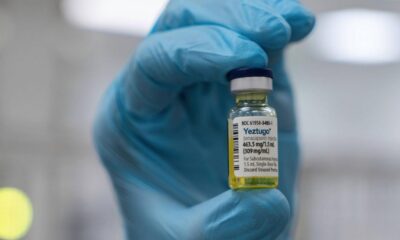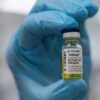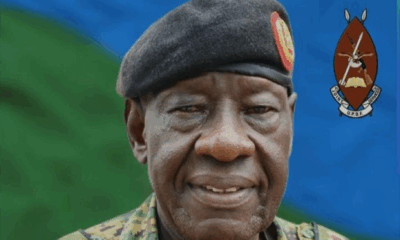News
WHO reveals cost of fighting COVID-19

WHO Director General Dr. Tedros Adhanom Ghebreyesus
The World Health Organization (WHO) has revealed that it will need the global community to raise a whoopping US$31billion (Approximately UGX117 trillion) in the coming 12 months alone, to combat the raging COVID-19 pandemic.
To put this figure into context Uganda’s budget for this year is 45 trillion
WHO says that it so far has US$3.4 billion realised under the effort code-named Access to COVID-19 Tools Accelerator (ACT Accelerator). This means that there is a funding gap of US$27.9 billion, of which $13.7 billion is urgently needed.
But the UN health agency, notes that the cost is just a tenth of what the International Monetary Fund (IMF) estimates the global economy loses every month due to COVID-19.
The unprecedented effort to combat the disease seeks to raise funds to develop unique tools including diagnostics, (testing), therapeutics, (treatment) and preventive (vaccines) that will be accessible to all nations.
The campaign to put in place the world’s first ever universal health response has brought together governments, foundations, individuals and non-governmental organisations to raise funds to invest and participate in the effort.
The universal approach to the pandemic is motivated by the fact that COVID-19 affects all nations globally and that no country is ever safe when it is left in other parts of the world.
WHO says: “The tools developed will benefit the whole world, and by saving lives and reducing severe COVID-19 disease, contribute to the goal of protecting health systems and restoring full societal and economic activity globally in the near term, and facilitating high-level control of COVID-19 disease in the medium term.
“The investment required is significant, but it pales in significance when compared to the cost of COVID-19: the total cost of the ACT-Accelerator’s work is less than a tenth of what the IMF estimates the global economy is losing every month due to the pandemic. Over 500,000 thousand people have already lost their lives,” says WHO
Pillar plans published early this week show a path to the accelerated development, equitable allocation, and scaled up delivery of 500 million tests to Low and Middle Income Countries (LMIC’s) by mid-2021, 245 million courses of treatments to LMICs by mid-2021, and 2 billion vaccine doses, of which 1 billion will be purchased for LMICs, by the end of 2021.
Launched at the end of April 2020, at an event co-hosted by the Director-General of the World Health Organization, the President of France, the President of the European Commission, and The Bill & Melinda Gates Foundation, the ACT-Accelerator brings together governments, health organizations, scientists, businesses, civil society, and philanthropists who have joined forces to speed up an end to the pandemic.
Since the ACT-Accelerator was launched, the partner organizations have moved fast to develop costed and implementable plans designed to contribute to the end of the pandemic through the accelerated development, equitable allocation, and scaled up delivery of new tools to reduce rapid mortality and severe disease, protecting health systems and restoring full societal and economic activity globally in the near term, and facilitating high-level control of COVID-19 disease in the medium term.
ACT-Accelerator investment case and costed plans
The ACT-Accelerator’s investment case and the plans published by the organizations leading each of the ‘pillars’ show a path to the accelerated development, equitable allocation, and scaled up delivery of 500 million diagnostic tests to LMIC’s by mid-2021, 245 million courses of treatments to LMICs by mid-2021, and 2 billion vaccine doses, of which 50% will go to LMICs by the end of 2021.
To achieve this, the costed plans presented early this week call for US $31.3 billion in funding for diagnostics, therapeutics and vaccines, of which US$3.4 billion has so far been pledged[2]. An additional US$27.9 billion is therefore needed, including US$13.7 billion to cover immediate needs (i.e. US$17.1 billion is immediately required, of which US$3.4 billion has been pledged).
The Pillars
The diagnostics pillar is co-led by FIND and the Global Fund to Fight AIDS, Tuberculosis and Malaria, and aims to save 9 million lives and avoid 1.6 billion further infections through the power of equitable access to simple, accurate and affordable tests.
With sufficient funding, it can bring to market 2–3 high-quality rapid tests, train 10,000 healthcare professionals across 50 countries, and establish testing for 500 million people in low- and middle-income countries. Its success will be determined by how quickly test, trace and isolate strategies can be put in place, to minimize disruption of health services and prepare countries for the effective roll-out of therapeutics and vaccines once available. The investment case is available here.
The therapeutics (treatments) pillar is led by Unitaid and the Wellcome Trust of UK (on behalf of the COVID-19 Therapeutics Accelerator) and seeks to accelerate the development and equitable delivery of treatments at all stages of the disease, ensuring they are accessible to all, regardless of geography and level of economic resource. It targets development, manufacture, procurement and equitable distribution of 245 million courses of treatment for populations in Low and Middle Income Countries within 12 months.
The vaccine pillar is co-led by the Global Alliance for Vaccines Initiative (GAVI) and CEPI, a global leader in vaccine development. WHO is using its oversight of regulation, policy and allocation experience.
Its role is to ensure that vaccines are developed as rapidly as possible, manufactured at the right volumes without compromising on safety and delivered to those that need them most. The current estimate to deliver 2 billion doses by the end of 2021, assuming a safe and effective vaccine is developed in the near future, is up to US$18.1 billion. In addition, 950 million doses will need to be procured by self-financing high-income countries and upper middle-income countries through the COVAX Facility.
WHO says: “These numbers will become clearer once we get a better idea of, among other factors, the technology that the successful vaccine candidates will be based on and the number of doses required to protect people from COVID-19.”
The health systems connector is the fourth pillar of the ACT-Accelerator and supports the other three by ensuring that health systems and local community networks can fully utilize these and other essential tools in their battle against COVID-19
This fourth pillar is led by the World Bank and the Global Fund to Fight AIDS, Tuberculosis and Malaria (GFATM) and supported by the WHO. It aims to build capacity – such as laboratory capacity, training for laboratory and health staff and management of protective equipment for health workers – needed to deploy the new tools effectively when they are ready.
It also works on system innovations to complement the roll-out of products, such as contact tracing, social distancing and isolation approaches as well as community engagement needed to sustain them. Global health security and the fight against COVID-19 depends on shoring up health systems around the world, now.
The Access to COVID-19 Tools ACT-Accelerator, is a new, groundbreaking global collaboration to accelerate the development, production, and equitable access to COVID-19 diagnostics, therapeutics, and vaccines. It was set up in response to a call from G20 leaders in March and launched by the WHO, EC, France and The Bill & Melinda Gates Foundation in April 2020.
WHO says that the ACT-Accelerator is not a decision-making body or a new organization, but works to speed up collaborative efforts among existing organizations to end the COVID-19 pandemic.
It is a framework for collaboration that has been designed to bring key players around the table with the goal of ending the pandemic as quickly as possible by reducing COVID-19 mortality and severe disease through the accelerated development, equitable allocation, and scaled up delivery of vaccines, therapeutics and diagnostics, thereby protecting health systems and restoring societies and economies in the near term.
Comments






















